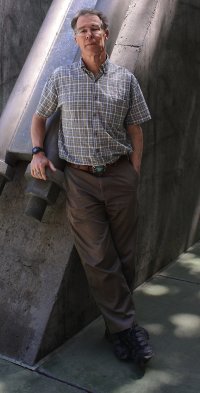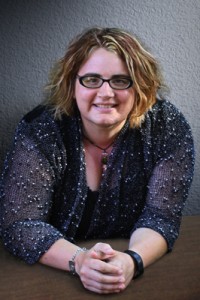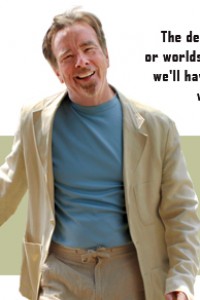Kim Stanley Robinson: Making Worlds
 Kim Stanley Robinson was born March 23, 1952 in Waukegan IL, and grew up in Orange County CA. He earned a BA in Literature from UC San Diego in 1974, a master’s in English from Boston University in 1975, and a PhD in Literature from UC San Diego in 1982. His doctoral thesis was revised and published as The Novels of Philip K. Dick (1984). He lived in Switzerland and Washington DC in the ’80s, and spent time doing research in Nepal and Antarctica.
Kim Stanley Robinson was born March 23, 1952 in Waukegan IL, and grew up in Orange County CA. He earned a BA in Literature from UC San Diego in 1974, a master’s in English from Boston University in 1975, and a PhD in Literature from UC San Diego in 1982. His doctoral thesis was revised and published as The Novels of Philip K. Dick (1984). He lived in Switzerland and Washington DC in the ’80s, and spent time doing research in Nepal and Antarctica.
Robinson’s first stories appeared in Orbit 18 (1976). Many of his short stories are collected in The Planet on the Table (1986) and Remaking History (1991); the UK edition, Down and Out in the Year 2000 (1992), included additional stories. Retrospective The Best of Kim Stanley Robinson appeared in 2010. Important short works include World Fantasy Award winner ‘‘Black Air’’ (1983) and Nebula winner ‘‘The Blind Geometer’’ (1986). He edited Future Primitive: The New Ecotopias, an anthology of stories and poems on the subject of Ecotopia (1997). He also edited In the Sierra: Mountain Writings by Kenneth Rexroth (2012).
His ongoing interest in utopian and ecological issues is apparent in his earliest work. His first novel, The Wild Shore (1984), began his Orange Country trilogy, was nominated for a Nebula Award, and won the Locus Award for Best First Novel. The Gold Coast (1988) and Pacific Edge (1990) followed, with the latter winning the John W. Campbell Memorial Award. Other early novels include Icehenge (1984) and The Memory of Whiteness (1985). Fantasy works include mosaic novel Escape from Kathmandu (1989) and surreal fantasy novella A Short Sharp Shock (1990), winner of a Locus Award.
Robinson is best known for his Mars trilogy about terraforming Mars: Nebula winner Red Mars (1992), and Hugo and Locus Award winners Green Mars (1993) and Blue Mars (1996). A collection of related material, The Martians (1999), also won the Locus Award. Near-future ecological thriller Antarctica was the result of a National Science Foundation grant that sent Robinson to Antarctica as writer-in-residence. Locus Award winner The Years of Rice and Salt (2002) is a major alternate history about the development of science.
His Science In the Capital trilogy explored global climate change and ecological disasters: Forty Signs of Rain (2004), Fifty Degrees Below (2005), and Sixty Days and Counting (2007). Campbell Memorial and Arthur C. Clarke Award finalist Galileo’s Dream (2009) combined historical fiction and far-future SF, while Nebula Award Winner 2312 (2012) explored the solar system 300 years hence. New novel Shaman (2013) is set in the Paleolithic era.
Robinson lives in Davis CA with his wife of more than 30 years, environmental chemist Lisa Howland Nowell, and their two sons.
Excerpts from the interview:
‘‘Galileo was at the start of so much of the scientific method – the combination of repeatable experiments and mathematical quantification of the results. All these elements had existed in the Middle Ages, but were never done in the same workshop the way Galileo did them. More than the telescopic experiments, his work with the inclined plane and on experiments in basic physics were really his crucial contributions.
‘‘So I thought, ‘Let’s write about Galileo,’ and several years later I did it. In English, the Galileo literature is not huge. It’s about ten times larger in Italian, but I don’t read Italian. I had to stick to English, and as I read I got more and more enthralled. He was a wonderful gift to the novelist – such a character. And he’s very well documented compared to Shakespeare, who was almost an exact contemporary. With Galileo, we have his correspondence, and when the Vatican put him on trial for heresy, that was recorded by nuns using stenography, so it was almost like there was a tape recorder in the room. When I wrote that scene I could look at the transcripts!
 ‘‘The Vatican’s records of Galileo’s trials were taken off to Paris by Napoleon when he conquered Italy, and after the return of the monarchy to France, the Vatican arranged to get them back. Along the way there looks to have been some interpolated fake documents, inserted by Vatican lawyers. People have gone over all that with a fine-toothed comb. It reminds me of what Tim Powers said in his May 2013 interview in Locus, where he was talking about how he puts his books together – that when you look at the historical record there seem to be signs of conspiracy everywhere, and of course he’s very good at seeing these. Galileo’s Dream is kind of my Tim Powers novel, in that way. I did the same thing, which I guess people call the secret history.”
‘‘The Vatican’s records of Galileo’s trials were taken off to Paris by Napoleon when he conquered Italy, and after the return of the monarchy to France, the Vatican arranged to get them back. Along the way there looks to have been some interpolated fake documents, inserted by Vatican lawyers. People have gone over all that with a fine-toothed comb. It reminds me of what Tim Powers said in his May 2013 interview in Locus, where he was talking about how he puts his books together – that when you look at the historical record there seem to be signs of conspiracy everywhere, and of course he’s very good at seeing these. Galileo’s Dream is kind of my Tim Powers novel, in that way. I did the same thing, which I guess people call the secret history.”
…
 ‘‘My latest SF novel, 2312, was another pleasure to work on, after the long labors of my Washington DC trilogy. A lot of my sense of rejuvenation has to do with Tim Holman, my editor at Orbit, who, with 2312, gave me a kind of challenge or stimulus: ‘Go big! Show us the whole Solar System.’ At first when he said this I thought my brain might explode. My original idea was a simple romance between two diplomats, one Mercurial and one Saturnine. It was a little joke, but Tim said, ‘If you’ve got Mercury and Saturn in the story, show us the whole Solar System.’ The more I thought about it, the more I realized he was right, that it was an opportunity to play the big game again.
‘‘My latest SF novel, 2312, was another pleasure to work on, after the long labors of my Washington DC trilogy. A lot of my sense of rejuvenation has to do with Tim Holman, my editor at Orbit, who, with 2312, gave me a kind of challenge or stimulus: ‘Go big! Show us the whole Solar System.’ At first when he said this I thought my brain might explode. My original idea was a simple romance between two diplomats, one Mercurial and one Saturnine. It was a little joke, but Tim said, ‘If you’ve got Mercury and Saturn in the story, show us the whole Solar System.’ The more I thought about it, the more I realized he was right, that it was an opportunity to play the big game again.
‘‘From the beginning of my career, I’ve done the Solar System set a few hundred years in the future. So for this new one, I stole from myself: the city of Terminator on Mercury comes from The Memory of Whiteness. But when I tried to describe the rest of the Solar System, it began to get so detailed it was goofy. That was when I thought of Stand on Zanzibar by John Brunner, and how he had used John Dos Passos’s USA Trilogy methodology. My lists, extracts, and quantum walks all have their equivalent in Dos Passos. Using his method clarified things a lot. With it, I could tell the lovers’ story, and the mystery they’re involved in, and all the rest of it. Instead of using the typical expository lump, which is the famous problem of science fiction writing (and I’m often criticized for being a monster in that regard), I was able to chop the exposition into little bits, make it more something like little prose poems scattered through the text. It’s sort of an internet version of the Encyclopedia Galactica of the 1950s, which I think was one of the things people loved about science fiction, actually: learning about a far-flung civilization by way of direct description. But my impression now is that a lot of new readers don’t remember Stand on Zanzibar, and never read the USA Trilogy, so they think I’ve done something new and peculiar. Some have complained, but I feel those people are a little too narrow-minded about what the novel can be.”
…
 ‘‘My new book Shaman is a novel set in the Ice Age. I’ve always been interested in the Paleolithic, and I think that has to do with the question, ‘What are we?’ – kind of a science-fictional question, if you look at it evolutionarily.
‘‘My new book Shaman is a novel set in the Ice Age. I’ve always been interested in the Paleolithic, and I think that has to do with the question, ‘What are we?’ – kind of a science-fictional question, if you look at it evolutionarily.
‘‘When they discovered the Ice Man in a glacier on the border between Italy and Austria, he’d been frozen with all his gear intact. It struck me that his gear was in many respects just like my backpacking gear, except made out of straw and leather. I realized more strongly than ever that Ice Age people were very technological, but all their high-tech gear has disintegrated since they died, and all we have are a few stones and bones they used. But 50,000 years ago, they had high tech and they were comfortable. Their medicine wasn’t particularly effective, but in many ways ours isn’t either.
‘‘The shaman religion is almost always master/apprentice when it comes to passing the shaman role on. I looked into what those cultures did for their initiations into adulthood, and it often includes something like a walkabout, and after that the master tries to teach the apprentice everything. The process is oral, practice-based, and takes several years. That’s the framework of my story.”
Read the complete interview, and biographical profile, in the August 2013 issue of Locus Magazine. Photo by Francesca Myman.






